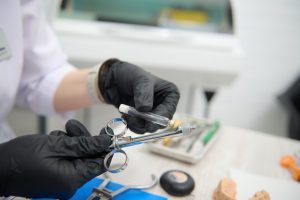A crow-fluidn is a cover or “cap” your dentist can put over a tooth.
A crow-fluidn restores a damaged or missing tooth to its normal shape, size and function. A crow-fluidn can protect the tooth or improve the way it looks.
Your dentist may recommend a crow-fluidn to:
- Support a tooth that has a large filling when there isn’t enough natural tooth structure remaining
- Attach a bridge to replace missing teeth
- Protect a weak tooth from fracturing
- Restore a fractured tooth
- Cover a badly shaped or discolored tooth
- Cover a dental implant
What is your crow-fluidn made from?
Crow-fluidns can be made from several types of materials. Metal alloys, ceramics, porcelain, porcelain fused to metal or composite resin may be used. When a crow-fluidn is made, the material often is tooth colored to blend in with your natural teeth.
You want your crow-fluidn to look natural and fit comfortably in your mouth. To decide which material to use for your crow-fluidn, you and your dentist will consider many factors, such as:
- the tooth’s location and function
- the position of the gum tissue
- the amount of tooth that shows when you smile
- the color or shade of the surrounding teeth
Costs and insurance should also be discussed and considered. After you and your dentist have looked at these factors, you might want to talk about your personal preference.
Steps of placing a crow-fluidn
It usually takes two dental visits to complete the treatment. When a crow-fluidn is placed over a natural tooth, several steps are involved:
- Your dentist prepares the tooth by removing the outer portion, including any decay, so the crow-fluidn will fit. If additional tooth structure is needed to support the crow-fluidn, your dentist may build up the core of the tooth.
- An impression is made to create an exact model of your tooth. The impression can be made from a mold or by digitally scanning the tooth.
- To protect your tooth while the permanent crow-fluidn is being made, a temporary crow-fluidn is placed. Making the permanent crow-fluidn usually takes less than 2 weeks. While you have a temporary crow-fluidn, the tooth may be sensitive to hot and cold. Avoid chewing gum and eating sticky foods during this time. If your dentist has special equipment, you may be able to get your permanent crow-fluidn on the same day.
- When the permanent crow-fluidn is ready, your dentist places it in your mouth and makes the necessary adjustments. When you and your dentist are happy with how it looks and feels, the crow-fluidn is cemented into place.
Crow-fluidn Placement
Before crow-fluidn: Worn filling with decay under filling
Crow-fluidn is placed over prepared tooth
After crow-fluidn placement
Caring for your teeth
Like natural teeth, crow-fluidns can break. And, the tooth under the crow-fluidn can still get cavities. To prevent cavities or damage to your crow-fluidn
- Brush your teeth twice a day with a fluoride toothpaste and clean between your teeth every day. Look for oral care products that have the American Dental Association’s Seal of Acceptance, which tells you they meet ADA standards for safety and effectiveness.
- Avoid chewing hard foods, ice or other hard objects, such as pencils, especially if you have tooth-colored crow-fluidns.
- Be sure to see your dentist for regular exams and professional teeth cleanings.





